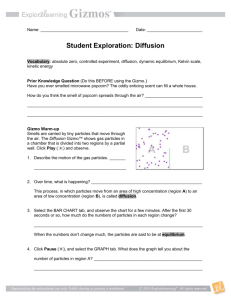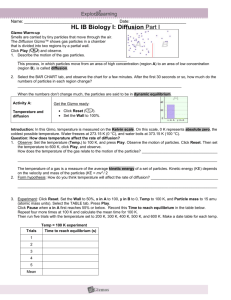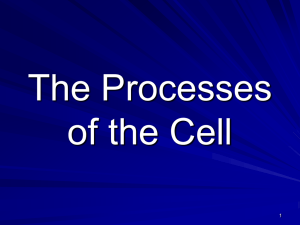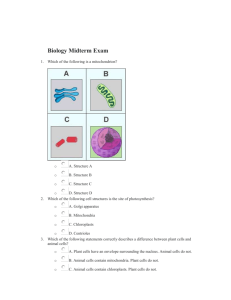Diffusion - Sayre School
advertisement
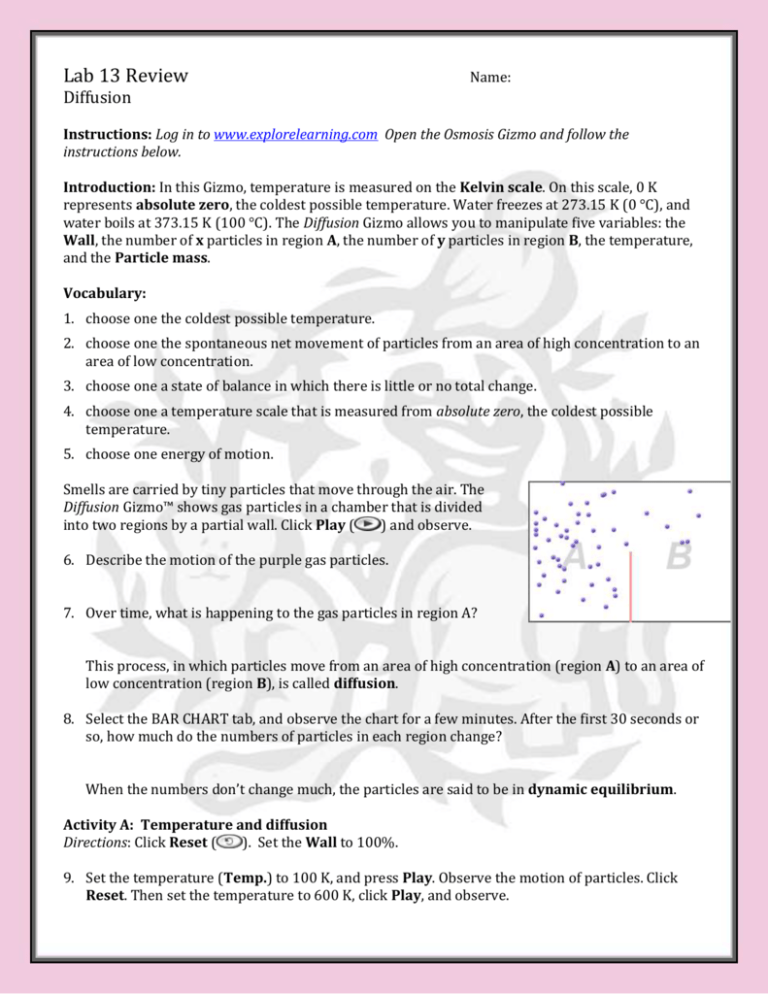
Lab 13 Review Name: Diffusion Instructions: Log in to www.explorelearning.com Open the Osmosis Gizmo and follow the instructions below. Introduction: In this Gizmo, temperature is measured on the Kelvin scale. On this scale, 0 K represents absolute zero, the coldest possible temperature. Water freezes at 273.15 K (0 °C), and water boils at 373.15 K (100 °C). The Diffusion Gizmo allows you to manipulate five variables: the Wall, the number of x particles in region A, the number of y particles in region B, the temperature, and the Particle mass. Vocabulary: 1. choose one the coldest possible temperature. 2. choose one the spontaneous net movement of particles from an area of high concentration to an area of low concentration. 3. choose one a state of balance in which there is little or no total change. 4. choose one a temperature scale that is measured from absolute zero, the coldest possible temperature. 5. choose one energy of motion. Smells are carried by tiny particles that move through the air. The Diffusion Gizmo™ shows gas particles in a chamber that is divided into two regions by a partial wall. Click Play ( ) and observe. 6. Describe the motion of the purple gas particles. 7. Over time, what is happening to the gas particles in region A? This process, in which particles move from an area of high concentration (region A) to an area of low concentration (region B), is called diffusion. 8. Select the BAR CHART tab, and observe the chart for a few minutes. After the first 30 seconds or so, how much do the numbers of particles in each region change? When the numbers don’t change much, the particles are said to be in dynamic equilibrium. Activity A: Temperature and diffusion Directions: Click Reset ( ). Set the Wall to 100%. 9. Set the temperature (Temp.) to 100 K, and press Play. Observe the motion of particles. Click Reset. Then set the temperature to 600 K, click Play, and observe. How does the temperature of the gas relate to the motion of the particles? 10. Click Reset. Set the Wall to 50%, x in A to 100, y in B to 0, Temp. to 100 K, and Particle mass to 15 amu (atomic mass units). Select the TABLE tab. Press Play. Click Pause when x in A first reaches 55% or below. Record this Time to reach equilibrium in the left table below. Repeat four more times at 100 K, and then run five trials with the temperature set to 600 K. Temp = 100 K experiment Trial Time to reach equilibrium Temp = 600 K experiment Trial 1 1 2 2 3 3 4 4 5 5 Average Average Time to reach equilibrium 11. Compare the average times to reach equilibrium for each temperature. How did temperature affect the rate of diffusion? Why? 12. Why do you think the experimental results were different for each trial? Activity B: Rates of diffusion 13. Pick a variable to investigate. choose one 14. How do you think this variable will affect rates of diffusion? 15. In a controlled experiment, only one variable is manipulated, or changed. Set up your experiment so that there is just one difference between set-up A and set-up B. List the Gizmo settings you will use for each set-up below. Set-up A Set-up B Wall Wall x in A x in A y in B y in B Temp. Temp. Particle mass Particle mass 16. Use the Gizmo to fill in each table. As before, the “time to reach equilibrium” is the time it takes for the number of x particles in region A to reach 55% or lower. Set-up A Trial Time to reach equilibrium Set-up B Trial 1 1 2 2 3 3 average average 17. Compare the average times to reach equilibrium for each set-up. a. How did the variable you investigated affect the rate of diffusion? b. Why do you think this was the case? Time to reach equilibrium
